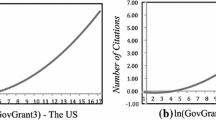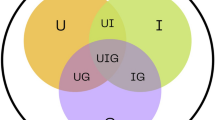Abstract
This paper simulates research networks in nanotechnology in Germany and the US. Agent-based modelling is used to analyse how public third-party funding influences the diffusion of a high technology by four different ways of funding. This diffusion is measured by the emerging number of nanoscientists. Next to the size of the national research systems and the number of scientists, the spread of nanotechnology is measured by interdisciplinarity and the probability of changing one’s disciplinary identity. The model is proper for the investigation of other high-technologies. Different ways of funding researchers can, according to the study results, influence the pattern of diffusion of a new technology in academia, in particular in the bigger research system of the US. While results are not significant for Germany, the way of funding researchers has significant effects in the US, with star scientists playing a crucial role for the distribution of public funding.



Similar content being viewed by others
Notes
For a current issue on homophily, see the theoretical and methodological discussion on the mechanisms of influence (e.g. by peers) and selection (homophily) and the difficulty of differentiating between the two. A discussion from a statistical-methodological point of view is provided in Steglich et al. (2010)
References
Abbott A (2005) The disciplines and the future. In: Brint S (ed) The future of the city of intellect. The changing American university. Stanford University Press, Stanford
Blau PM (1977) Inequality and heterogeneity. A primitive theory of social structure. The Free Press, New York, London
Blau PM (1994) Structural contexts of opportunities. The University of Chicago Press, Chicago, London
Bundesministerium für Bildung und Forschung (BMBF) (2009) Forschung und Innovation für Deutschland [Research and innovation for Germany]. Bundesministerium für Bildung und Forschung (BMBF), Berlin
Casper S (2009) Can new technology firms succeed in coordinated market economies? A response to Herrmann and Lange. Socio-Econ Rev 7:209–215
Cioffi-Revilla C (2010) Computation social science. Wiley Interdiscip Rev: Comput Stat 2:259–271
Davis JA (1970) Clustering and hierarchy in interpersonal relations: testing two graph theoretical models on 742 sociomatrices. Am Sociol Rev 35:843–851
De Solla Price DJ (1965) Networks of scientific papers. Science 149:510–515
Etzkowitz H (2003) Public venture capital: the secret life of U.S. science policy. In: Biegelbauer PS, Borrás S (eds) Innovation policies in Europe and the U.S.: a new agenda. Ashgate Publishing, Hampshire, Burlington
Gilbert N, Troitzsch KG (1999a) Simulation as a method. In: Gilbert N, Troitzsch KG (eds) Simulation for the social scientist. Open University Press, Buckingham; Philadelphia
Gilbert N, Troitzsch KG (1999b) Simulation and social science. In: Gilbert N, Troitzsch KG (eds) Simulation for the social scientist. Open University Press, Buckingham; Philadelphia
Gilbert N, Jager W, Deffuant G, Adjali I (2007) Complexities in markets: introduction to the special issue. J Bus Res 60:813–815
Hagstrom WO (1970) Factors related to the use of different modes of publishing research in four scientific fields. In: Nelson CE, Pollock DK (eds) Communication among scientists and engineers. Heath Lexington Books D.C. Heath, Lexington
Hancké B, Rhodes M, Thatcher M (2007) Introduction: beyond varieties of capitalism. In: Hancké B, Rhodes M, Thatcher M (eds) Beyond varieties of capitalism. Oxford University Press, Oxford, New York
Hedström P (2008) Studying mechanisms to strengthen causal inferences in quantitative research. In: Box-Steffensmeier JM, Brady HE, Collier D (eds) The Oxford handbook of political methodology. Oxford University Press, Oxford
Hüning L, Langer MF (2006) Der MASTERMARKT nach Bologna. Den Markt für Master-Programme verstehen, Strategien gestalten [The Market of Master Degrees after Bologna. Understanding the Market of Master Programs, Creating Strategies] (CHE Centrum für Hochschulentwicklung, Gütersloh)
Jackson MO (2008) Social and economic networks. Princeton University Press, Princeton
Jansen D, von Görtz R, Heidler R (2010) Is nanoscience a mode 2 field? In: Jansen D (ed) Governance and performance in the German public research sector. Springer, Dordrecht
Lotka AJ (1926) The frequency distribution of scientific productivity. J Wash Acad Sci 16:317–323
Merton RK (1968) The Matthew effect in science. Science 159:56–63
Moody J (2004) The structure of a social science collaboration network: disciplinary cohesion from 1963 to 1999. Am Sociol Rev 69:213–238
Mutschke P (2010) Zentralitäts- und Prestigemaße [Measures of centrality and prestige]. In: Stegbauer C, Häußling R (eds) Handbuch Netzwerkforschung. Verlag für Sozialwissenschaften, Wiesbaden
National Nanotechnology Coordination Office (2010) NNI Budget, 2009–2011 (Arlington, VA)
National Science Foundation (NSF) (2008) NSF Award Search (Arlington, VA)
National Science Foundation (NSF) (2010) Science and Engineering Indicators 2010 (Arlington, VA)
Pattison P, Robins G (2002) Neighbourhood-based models for social networks. Sociol Method 32:301–337
Powell WW, White DR, Koput KW, Owen-Smith J (2005) Network dynamics and field evolution: the growth of interorganizational collaboration in the life sciences. Am J Sociol 110:1132–1205
Schweinberger M, Snijders TAB (2003) Settings in social networks: a measurement model. Sociol Method 33:307–341
Schummer J (2007) The global institutionalization of nanotechnology research: a bibliometric approach to the assessment of science policy. Scientometrics 70:669–692
Squazzoni F (2010) The impact of agent-based models in the social sciences after 15 years of incursions. Hist Econ Ideas 18:197–233
Steglich C, Snijders TAB, Pearson M (2010) Dynamic networks and behavior: separating selection from influence. Sociol Method 40:329–393
Streeck W, Thelen K (2001) Introduction: institutional change in advanced political economies. In: Streeck W, Thelen K (eds) Beyond continuity. institutional change in advanced political economies. Oxford University Press, Oxford
Thelen K (2004) How institutions evolve. the political economy of skills in Germany, Britain, the United States, and Japan. Cambridge University Press, Cambridge
VDI Technologiezentrum e.V. (2009) nano.DE-Report 2009 (Federal Ministry of Education and Research (German), Bonn; Berlin)
Zucker LG, Darby MR (2001) Capturing technological opportunity via Japan’s star scientists: evidence from Japanese firms’ biotech patents and products. J Technol Transf 26:37–58
Acknowledgements
The author is thankful for comments and suggestions by Richard Münch, Björn-Christopher Witte, and Ali Abbas, as well as for financial support received by the German Research Association (Deutsche Forschungsgemeinschaft, DFG).
Author information
Authors and Affiliations
Corresponding author
Electronic Supplementary Material
Below is the link to the electronic supplementary material.
Rights and permissions
About this article
Cite this article
Hoser, N. Public funding in the academic field of nanotechnology: a multi-agent based model. Comput Math Organ Theory 19, 253–281 (2013). https://doi.org/10.1007/s10588-013-9158-x
Published:
Issue Date:
DOI: https://doi.org/10.1007/s10588-013-9158-x




